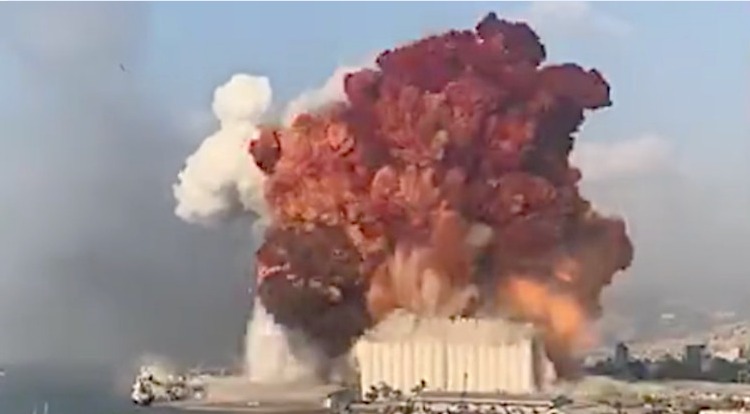In a world dominated by smartphones, who would have thought that this old pager could become a devastating tool? Scores of people were killed and thousands injured, including a young girl, after a devastating pager explosion rocked Lebanon.
Thousands of pagers detonated across the country, leaving hundreds of Hezbollah fighters, medical personnel, and civilians among the injured. With at least 200 in critical condition, the scale of the damage is severe.
Hezbollah – the powerful political and paramilitary wing in Lebanon, has blamed Israel for what it called the “biggest security breach” in nearly a year of conflict. A Hezbollah official declared Israel “fully responsible” for the coordinated explosions, saying, “The enemy stands behind this incident targeting the devices,” without providing further details.
This isn’t the first time Lebanon has been struck by a devastating “security breach.” The infamous 2020 explosion, still remembered as one of the most powerful non-nuclear blasts in history, continues to haunt the nation.
Mossad’s Alleged Involvement
According to Reuters, citing informed sources, Israel’s spy agency – Mossad, had a hand in the pager explosions. The agency reportedly planted explosives in 5,000 pagers imported by Hezbollah earlier this year. The plot, months in the making, was triggered when a coded message activated 3,000 of the devices simultaneously.
Taiwan Or Hungary: Where Did Israeli Spy Agency Sabotage The Pagers That Are Exploding In Lebanon?
A senior Lebanese source confirmed that Mossad had tampered with the pagers “at the production level,” making the explosives virtually undetectable. Up to three grams of explosives were hidden in each pager, eluding Hezbollah’s scrutiny for months. An explosive component was used in the devices that could be remotely triggered—impossible to detect with any scanner.
Military analyst Elijah Magnier provided further details to Al Jazeera, explaining that the explosive used was likely PETN (Pentaerythritol tetranitrate), embedded within the pagers’ electronic circuits. The sophisticated nature of the operation points to the involvement of a state-level intelligence agency.
The method of detonation involved sending error-laden messages to the pagers, causing them to vibrate before exploding. This resulted in severe injuries, with over 300 people losing both hands and many others suffering eye and abdominal injuries. The investigators were able to reach these conclusions from the pagers that did not explode, Magnier said.
The New York Times (NYT), referencing two members of Iran’s Revolutionary Guard Corps has reported that Iran’s ambassador to Lebanon, Mojtaba Amini, has lost one eye and suffered severe injuries to the other as a result of yesterday’s pager explosions.
While Israel has remained silent on the matter, the incident occurred shortly after the Israeli cabinet expanded its war objectives to include the repatriation of residents displaced by Hezbollah’s attacks in northern Israel.

The 2020 Beirut Explosion
Lebanon’s recent pager explosion has revived the haunting memories of a devastating explosion four years ago.
On August 4, 2020, as the world battled the COVID-19 pandemic, a massive explosion at the Port of Beirut unleashed devastation upon Lebanon’s capital. This catastrophe claimed 218 lives, injured 7,000, and displaced 300,000 residents, leaving enduring scars on a nation already grappling with its own turmoil.
Regarded as one of the largest non-nuclear blasts ever recorded, the explosion damaged 77,000 apartments and caused material losses estimated between $3.8 to $4.6 billion, according to the World Bank.
Reports indicated that the blast was so immense it physically shook Lebanon and sent shockwaves across the region. The tremors were felt in Turkey, Syria, Palestine, Jordan, and Israel, while parts of Europe experienced the reverberations. The explosion was heard in Cyprus, over 240 km (150 miles) away.
The US Geological Survey registered the blast as a seismic event with a magnitude of 3.3. It was one of the most powerful non-nuclear explosions in history, impacting even the Earth’s ionosphere. It remains the largest single-fired ammonium nitrate explosion ever recorded.
So, what sparked the Beirut explosion? A fire at the port ignited 2,750 tonnes of ammonium nitrate that had been improperly stored in a warehouse for six years. This substance had arrived in Beirut in 2013 on the Rhosus, a Moldova-flagged ship (owned by a Russian businessman) en route from Georgia to Mozambique.
The explosion occurred at the warehouse facility storing ammonium nitrate (AN) at Beirut port. Ammonium nitrate is commonly used both as a fertilizer and in explosive materials.
Fertilizer-grade ammonium nitrate has lower porosity and higher density than the type used in explosives. In 1996, it was classified as a hazardous substance under the Seveso II Directive (European Parliament and Council of the European Union, 2003).
After facing technical problems at sea, the vessel was forced to dock in Beirut and was later impounded by Lebanese authorities for unpaid port fees. In 2014, its cargo was unloaded and stored in the port warehouse.
Despite numerous safety warnings sent to high-level officials over the years, no action was taken. The explosion on August 4, 2020, was a tragic result. Nearly two years later, on July 31, 2022, a section of Beirut’s grain silos collapsed following a weeks-long fire, a grim reminder of the blast’s enduring impact.
The primary causes of the accident at Beirut’s port were government mismanagement and corruption. The evidence raised questions regarding whether the ammonium nitrate was meant for Mozambique, as the Rhosus’s shipping documents claimed, or if Beirut was its actual destination.
Additionally, the evidence suggests that various Lebanese authorities may have been criminally negligent under Lebanese law in their handling of the Rhosus’s cargo.

Beirut Blast: Conspiracy Theories
Following the blast, social media initially speculated that it was caused by a nuclear bomb due to the white, mushroom-like cloud visible in some footage. This theory was later disproved.
Additionally, there were false claims circulating on social media suggesting that the explosion was an Israeli attack, either a bomb or a missile strike on a Hezbollah weapons depot.
Thanks To U.S. & India, Israel’s Weapons Sale ‘Breaking Records’ Despite War On Multiple Fronts
“We’ve seen known disinformation sources, including far-right extremist networks online, spreading baseless claims about the nature and motivations behind the blast. This has included theories attempting to link the explosion to Israel or other nation-states,” said Chloe Colliver from the Institute for Strategic Dialogue while talking to BBC News.
In the aftermath, suspicions emerged about Hezbollah’s involvement, fueled by claims that the explosion occurred at a site associated with the group’s weapons storage. Hezbollah denied these allegations but has actively protested the investigation.
Social media buzzed with conspiracy theories suggesting that Israel had targeted the Hezbollah weapons cache, leading to the unexpected scale of destruction.
Interestingly, all parties—Israel, Lebanon, and Hezbollah—have dismissed these theories, attributing the blast to the improperly stored ammonium nitrate.
In response to the disaster, the Lebanese government declared a two-week state of emergency. Following the blast, widespread protests erupted across Lebanon, criticizing the government for its failure to prevent the tragedy.
These demonstrations were part of a broader wave of protests that had been ongoing since 2019. On August 10, 2020, Prime Minister Hassan Diab and the Lebanese cabinet resigned.
Vulnerabilities In Security Infrastructure
Whether it was the recent pager attack or the 2020 Beirut explosion, both events had one thing in common: They highlighted the weak points of Lebanon’s security system, whether it was the mishandling of hazardous materials or complex infiltration by foreign agents. The message is clear: Lebanon remains a nation on edge.
The pager explosion in Lebanon also marks a worrying new chapter in modern warfare. It shows that our increasingly interconnected world is rife with threats from the most unlikely of sources.
Outdated technology has evolved into a formidable weapon of destruction. We live in an era where even a pager can be a bomb, and it is difficult to understand what other dangers are hidden in plain sight.
- Shubhangi Palve is a defense and aerospace journalist. Before joining the EurAsian Times, she worked for E.T. Prime. In this capacity, she focused on covering defense strategies and the defense sector from a financial perspective. She offers over 15 years of extensive experience in the media industry, spanning print, electronic, and online domains.
- Contact the author at shubhapalve (at) gmail (dot) com.




